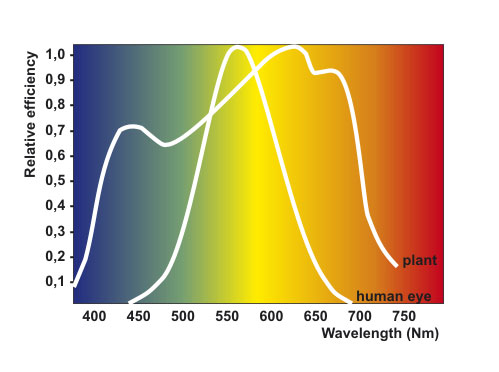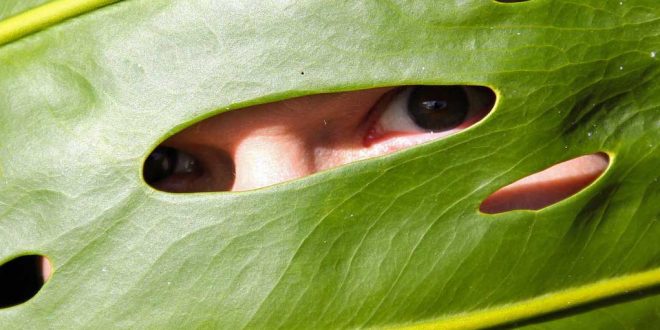Plants can see us. They can monitor their visible environment. They can see if you’re wearing a red or blue shirt. They know if you’re moving them from one place of your house to another. When you take a picture turning the flash on for a better and clearer image, plants know that. They can see the other plants that you put beside them. They see the sun setting down and coming up from the horizon. But to understand the term plant’s sight clearly, we have to understand what sight is.
Read this article in Bengali: গাছ কি আমাদের দেখতে পায়?
What is “Sight”?
According to Merriam-webster ‘sight is a perception of an object by eye or as if by the eye’. Plants don’t have eyes. And they definitely lack a brain. In our case, when the photoreceptors in our eyes get stimulated by visible lights, our nervous system translates that light signal into a picture we call sight. Because plants don’t have a nervous system or brain they can’t translate light signals into a whole image. Although they can receive and detect light and respond to these lights in their own way. Still, can we call this ability ‘sight”?
To understand that, let’s think of a blind man. A blind man sees nothing, he can’t detect any light. The cause of it may be his photoreceptors or optical nerves are damaged. Now, miraculously he retained the ability to differentiate light and shadow. He can understand when he is inside or outside. These new senses would be considered a primitive stage of sight and would enable him to a new level of functions. Furthermore, if he develops the ability to discern different colors like blue or red, or green. That’s a lot of improvement right? From total blindness, he developed some drastic changes to see things. Though he is still not able to translate these received light into an object. We can all agree that he is now seeing things. He has developed a somewhat primitive stage of sight.
The same thing goes for plants. Plants are like this blind man. Though they can’t see like us. They’ve got this blind man’s sight.

Plants Vision
To survive in an environment, plants need to be aware of the dynamic visual surroundings. They need to know the amount, duration, direction, and color of light. However, plants don’t see exactly like us. Their vision doesn’t create a full image. Plants can’t differentiate faces. They can’t understand the difference between you and your friend both wearing the same blue dresses. But they can see light in many lengths and colors which we can just only imagine. Plants can see the ultraviolet rays that give us sunburns. They can see the infrared lights that heat us.
They can even understand how long the lights have been on. They know if the light is coming from the left, right, or above. They see if another plant is growing above them, blocking their lights and giving them shadows. They understand the difference between shadow and light. They can understand if it is winter or summer by seeing the length of the days.

The Difference between Us and Plants
- Plants detect visible and invisible electromagnetic waves. Unlike plants, we can only detect visible electromagnetic waves.
- Although plants can see a much larger spectrum than we do, they don’t see it in images.
- The photoreceptor which receives red light is called red photopsin in the case of humans. And in the case of plants, they are called phytochrome. Though both of them receive the same red light, they are not made of the same protein. Phytochrome is responsible for phototropism in plants.
- Both animals and plants contain blue light receptors called cryptochromes. Cryptochromes aren’t responsible for phototropism but control the ‘circadian clock‘ in plants and animals. cytochromes absorb blue light and signals that it is daytime. In plants, they control leaf movements, photosynthesis, etc.
*Circadian Clock
The circadian clock is an internal clock that is in tune with normal day-night circles. In our case, the activities we do in 24 hours are controlled by the circadian clock. When we will go to sleep and wake up. Even when we will go to the bathroom. If we keep ourselves in a dark room it will still work. But when we travel to different time zones our circadian clocks get disrupted and we suffer from jet lag. Blue light can reset this clock, but it’ll take a few days.
Similarly, we can disrupt the circadian clock of a plant. If we artificially change plants’ day-night circle, we’ll notice an absurd behavior. If the flowers on that plant used to bloom in the morning, they’ll start to bloom at night. Just like human jet lags. but if we keep it in light for a few days the circadian clock will reset.

References & Other Links
What A Plant Knows by Daniel Chamovitz
 Plantlet The Blogging Platform of Department of Botany, University of Dhaka
Plantlet The Blogging Platform of Department of Botany, University of Dhaka






What plants have the best vision? What devices would be used to measure those levels?
As the vision of plants is a lot different than that of animals with eyes it is hard to tell about their best vision. I’d say the plants which have black leaves have the best vision as they can absorb a broad range of light and doesn’t reflect green color like most plants. To measure the level of vision (aka light sensitivity) crescograph and close inspection will be needed.
Plants DO NOT “see light.” They receive Electromagnetic Radiation. The photo-receptive pigments perform the same functions, in plants as the frequency-specific electronic components of a phased-array radar. Thinking of the radiation that plants can potentially benefit from as Photobiologically Active Radiation (PbAR) gives us access, thanks to Wave Theory, to the body of knowledge that allows us to transmit decipherable packets of electronic information across, literally, tens of billions of miles to a, relatively-speaking, tiny target.
The phenomenon we need to turn greater attention to is constructive interference; or, as it’s called in music, “harmony.“
Plants DO NOT “see light.” They receive Electromagnetic Radiation. The photo-receptive pigments perform the same functions, in plants as the frequency-specific electronic components of a phased-array radar. Thinking of the radiation that plants can potentially benefit from as Photobiologically Active Radiation (PbAR) gives us access, thanks to Wave Theory, to the body of knowledge that allows us to transmit decipherable packets of electronic information across, literally, tens of billions of miles to a, relatively-speaking, tiny target.
The phenomenon we need to turn greater attention to is constructive interference; or, as it’s called in music, “harmony.“
Then We can also say that we don’t see light, we just receive electromagnetic radiation ranging from approx 400 to 700nm. That’s all. Sometimes the words used don’t bear the exact meaning. Rather they are used metaphorically. That’s what I have done here. And why we are saying that plants can see is also described in two big paragraphs. And also why the word “sight”. I would be very glad if you give your attention to those explanations. All of these is explained by Daniel Schimovitz, a professor of Tel Aviv university in his book “What a Plant Knows”. I… Read more »